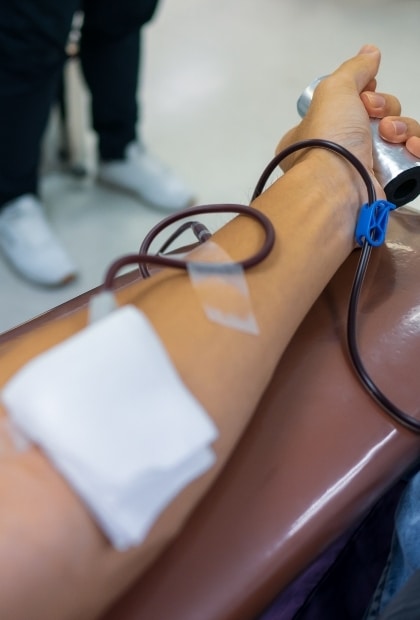All you need to know about HIV
HIV
What HIV is
Human immunodeficiency virus, which is widely known as HIV, is the virus that causes AIDS (acquired immunodeficiency syndrome). AIDS is a serious, life-threatening illness with a variety of symptoms. Since there is no cure for HIV infection, it can be treated with medications to make patients feel better and to prolong life (1).
There were approximately 38 million people worldwide with HIV/AIDS in 2019. More than 36 million were adults and almost 1.8 million were children. Most people with HIV are in low- and middle-income countries (2).
A total of 38 172 notifications of HIV have been reported in Australia since 1984, of which 34 800 were among males and 3 021 among females.
In 2017, it was estimated that there were 27545 people with HIV in Australia. At the same year, the largest number of notifications was in the age group 30–39 years. There were an estimated 2899 (11%) people living with HIV in Australia in 2017 who were unaware of their HIV status, meaning that they were undiagnosed.
In 2017 HIV prevalence (the proportion of all people in Australia who are living with HIV), was estimated to be 0.14%, which is low compared with other relevant high‑income and Asia‑Pacific countries.
There were 963 HIV notifications in Australia in 2017, which is a 5% decline compared to the year 2016. Moreover, this was the lowest number of notifications since 2010 (3).
Ways of infection with HIV
Although people nowadays are more informed about HIV, there is still a misconception in part of the society that if you touch an infected person or contact surfaces like toilet seats you might get HIV which is not true at all. Additionally, HIV infection is not transmitted through saliva.
Here are the ways that you might get infected with HIV:
- Body fluids, including vaginal secretions, semen, rectal fluids (through sexual contact with an infected person), and blood. However, to get infected with these fluids they must either contact with mucous membranes or go directly into the bloodstream. In terms of HIV transmission, anal sex is considered as the type of sexual activity that increases the risk of transmission.
- Sharing needles or other equipment to inject drugs with someone who has HIV.
- Infected blood or blood products through transfusion. This is very rare nowadays in Australia but can happen in countries where blood and blood donors are not tested for HIV.
Women with HIV infection can transmit the virus to their babies during pregnancy, at the time of birth, or through breastfeeding (4).
At this point, it is important to highlight that people with HIV who are taking antiretroviral therapy and are virally suppressed do not transmit HIV to their sexual partners. Therefore, antiretroviral therapy is crucial not only to improve the health of people with HIV but also to prevent HIV transmission (5).


Are you at risk for HIV?
There are some specific categories of people who are at greater risk of HIV infection:
- Being a gay or bisexual
- Having unprotected anal or vaginal sex
- Having another sexually transmitted infection such as chlamydia, gonorrhoea syphilis, herpes, and bacterial vaginosis
- Sharing contaminated needles, syringes and other injecting equipment and drug solutions when injecting drugs
- Receiving unsafe blood transfusions, injections, and tissue transplantation, and medical procedures that involve unsterile cutting or piercing
- Health workers who are experiencing accidental needle stick injuries
- Living in specific geographical areas. Over 2/3 of all people living with HIV live in the WHO African Region (5)
- Exposure to the virus as a fetus or infant before or during birth or through breastfeeding from a mother who is HIV positive (6).
The rate of HIV notifications increased by 41% in the Aboriginal and Torres Strait Islander population between 2013 and 2016, compared with a 12% decline in Australian‑born non‑Indigenous people, and in 2017 remains 1.6 times as high as the Australian‑born non‑Indigenous population (3).
Symptoms of HIV infection
Many people with HIV infection may not feel sick for a long time which is called asymptomatic infection and can be asymptomatic for several years following infection.
Acute infection can be noticed in about 2/3 of the infected people. It is characterized by symptoms including fever, rash, lymphadenopathy, pharyngitis, myalgia, diarrhoea, about 2 weeks after exposure.
As the infection progressively weakens the immune system, they can develop other signs and symptoms, such as swollen lymph nodes, weight loss, fever, diarrhoea and cough (7).

Complications of untreated HIV
In case HIV is untreated, severe illnesses may develop including severe bacterial infections, tuberculosis, cryptococcal meningitis, and cancers such as Kaposi’s sarcoma and lymphomas (5).
HIV Diagnosis
HIV can be diagnosed through rapid diagnostic tests that provide same-day results. This greatly facilitates early diagnosis and linkage with treatment and care. Despite the fact of widely available HIV self-tests, no single test can provide a full HIV diagnosis; confirmatory testing is required, conducted by a qualified and trained health or community worker at a community centre or clinic (5).
Most widely used HIV diagnostic tests detect antibodies produced by the infected person’s immune system as a response against the HIV infection. Usually, people develop antibodies to HIV within 28 days of infection. During this time, people experience the so-called “window” period – when HIV antibodies haven’t been produced in high enough levels to be detected by standard tests and when they may have had no signs of HIV infection, but also when they may transmit HIV to others. Following a positive diagnosis, people should be retested before they are enrolled in treatment and care to rule out any potential testing or reporting error (5).


Treatment for HIV
HIV can be suppressed by treatment regimens composed by a combination of 3 or more antiretroviral therapy drugs. HIV infection is not cured by current antiretroviral therapy. However, this therapy highly suppresses viral replication within a person’s body and allows an individual’s immune system recovery to strengthen and regain the capacity to fight off infections. Since 2016, WHO recommended that all people living with HIV be provided with lifelong antiretroviral therapy, including children, adolescents and adults, and pregnant and breastfeeding women, regardless of clinical status. The current HIV treatment guidelines include new antiretroviral options with better tolerability and higher efficacy. In 2019, WHO recommended the use of dolutegravir-based or low-dose efavirenz for first-line therapy (5).
Take away message
Recently developed treatments allow individuals infected with HIV to live for decades having a good quality of life. People can reduce the risk of HIV infection by limiting exposure to risk factors. Correct and consistent use of male and female condoms during vaginal or anal penetration can protect against the spread of HIV and other sexually transmitted diseases as well. According to scientific studies, male latex condoms when used consistently have an 85% or greater protective effect against HIV.
References
- Stevens LM, Lynm C, Golub RM. HIV Infection: The Basics. JAMA. 2012;308(4):419. doi:10.1001/jama.2012.4079
- HIV.gov. 2020. Global Statistics. [online] Available at: <https://www.hiv.gov/hiv-basics/overview/data-and-trends/global-statistics> [Accessed 26 September 2020].
- Kirby.unsw.edu.au. 2019. HIV, Viral Hepatitis And Sexually Transmissible Infections In Australia: Annual Surveillance Report 2018 | UNSW – The Kirby Institute For Infection And Immunity In Society. [online] Available at: <https://kirby.unsw.edu.au/report/hiv-viral-hepatitis-and-sexually-transmissible-infections-australia-annual-surveillance> [Accessed 31 August 2020].
- Malani PN. Human Immunodeficiency Virus. JAMA. 2016;316(2):238. doi:10.1001/jama.2016.7995
- Who.int. 2020. HIV/AIDS. [online] Available at: <https://www.who.int/news-room/fact-sheets/detail/hiv-aids> [Accessed 26 September 2020].
- https://www.nichd.nih.gov/. 2016. Who Is At Risk Of HIV/AIDS?. [online] Available at: <https://www.nichd.nih.gov/health/topics/hiv/conditioninfo/risk> [Accessed 26 September 2020].
- Sti.guidelines.org.au. 2018. HIV – Australian STI Management Guidelines. [online] Available at: <http://www.sti.guidelines.org.au/sexually-transmissible-infections/hiv#clinical-presentation> [Accessed 26 September 2020].
IMPORTANT: If you believe you may have been exposed to HIV in the last 72 hours do not proceed with a normal STI test, visit a doctor, hospital or specialty clinic ASAP so you can receive preventative post-exposure treatment (PEP).
It can take up to 12 weeks for the HIV antibodies to show up in your system so if you believe you may have been exposed to HIV and are outside of the 72 hour window, but within the 12 week window period, you can and should get tested immediately, but it’s important that you return or seek further medical advice after the 12 week window has passed to be tested again to be sure.
If you believe you may have been exposed to HIV and are distressed visit our Resources section where you will find the contact information for several Sexual Health info lines operating across Australia, they’ll be able to speak to you about your concerns and help you get the attention you need.
HIV FAQs
We all know that HIV (Human Immunodeficiency Virus) is serious. If you’ve never really read much about this condition, it attacks the immune system using its cells to reproduce itself and weakening it over time eventually resulting in Acquired Immune Deficiency Syndrome or as it’s less formally known AIDS.
Early detection is our best weapon against HIV and is one of the key reasons Stigma Health is trying to make the process of getting tested much easier and less unnerving. With effective, early treatment, people can manage HIV and live long productive lives; however, you need to know you have it for this to start!
When you visit the Pathology Centre your Stigma Health referral will allow you to get a simple blood test that will be examined for HIV antibodies, which are found in the blood of anyone infected with the virus. If this is more than just a routine test for you or your partner, it is extremely important that you do not engage in any sexual activity until you have the results and know that you are both safe.
There is sadly still no cure for HIV, however taking the prescribed antiretroviral drugs can keep virus replication suppressed, and prevent the progression from HIV to AIDS.
We repeat: It is possible to live a long and fulfilling life with HIV, but early detection and treatment is vital.
